Berisso, Argentina
Berisso is a unique city in Argentina and arguably entire world in the significance it puts on its immigrant cultures.
The city may have a population of merely 100 000 yet it has two Lithuanian clubs and many other ethnic clubs (Polish, Greek, Italian, Armenian, Croat, etc.).
Berisso adopted the title “capital of the immigrants” and its ethnic minorities are traditionally called “immigrants”. In reality, however, today there are very few immigrants and most of the immigrants are actually sons/daughters, or, more likely, grandsons/granddaughters or great-grandsons/great-granddaughters of the original immigrants. That’s because the massive wave of immigration to Berisso took place prior to World War 2 and immigrants used to work at the slaughterhouses (which closed down in 1982) and the petroleum plant (which still operates). It was then when most of the forefathers of today’s people of Berisso immigrated. It is said some 3000 Lithuanians also were among these migrants. Although generations changed, their attachment to Lithuania did not disappear. A significant part of Berisso life revolves around the ethnic clubs which regularly prepare their traditional dishes and, once October comes, participate in the Berisso Immigrant festival. It is a very important city event and a fire similar to Olympic fire burns throughout it.
Even children of mixed ancestry often join one of the ethnic clubs in order to be able to participate in the Immigrant festival together with the ethnic dance and singing teams. Sometimes the youth would even join a club not based on their ancestry but instead based on where their friends belong to. As an example, some ~20% of Lithuanian club “Mindaugas” members have no Lithuanian ancestry at all yet they participate in Lithuanian activities and, in some cases, even try to learn Lithuanian language.
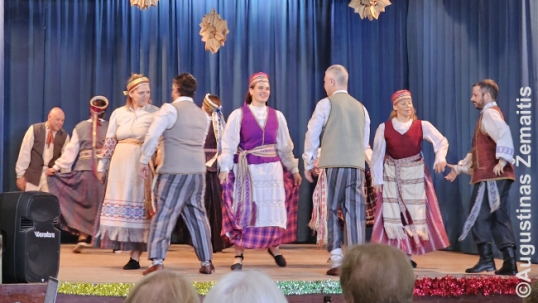
Lithuanian folk dancers in Berisso
Lithuanian club „Nemunas“
“Nemunas” is the oldest Lithuanian organization in Argentina (established 1909 08 17, long before the main wave of Lithuanian migration into Argentina of the 1920s-1930s). Despite this, “Nemunas” has some of the youngest active member ranks in Argentina and probably the entire Lithuanian diaspora from the areas with no current Lithuanian immigration. Third-generation Lithuanian-Argentines and fourth-generation Lithuanian-Argentines participate in its activities and leadership roles. They not only dance the Lithuanian dances but soem of them speak Lithuanian language as well.

Lithuanian club “Nemunas” of Berisso
The façade of the “Nemunas” club is adorned by a bas-relief “Lithuania” that has been created by Cristian del Vito, Karina Ankudowicz, G. Ponce and Kristina Natale in 2001 to commemorate the 92nd anniversary of the establishment of the club. The bas-relief depicts the “School of sorrows” (an illegal Lithuanian school operating at the times of Russian Imperial rule in Lithuania when Russians banned the teaching in Lithuanian – 1863-1904), traditional Lithuanian crops, crosses, roof and wooden homes of small Lithuanian towns. Lithuanian inscription declares „Mūsų vienybė yra mūsų stiprybė“ – “Our unity is our strength”.
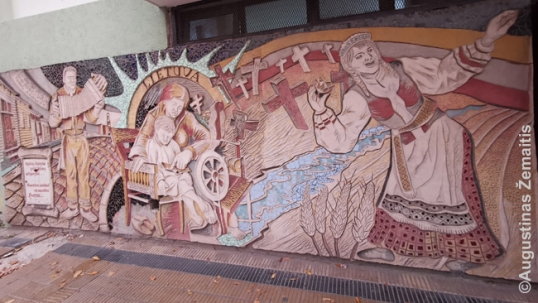
Bas-relief Lithuania on the façade of the club Nemunas
The heart of “Nemunas” club is its main hall, adorned in Lithuanian symbols, and the second-floor premises with a library (balustrade of the second floor incorporates the Columns of Gediminas symbol). The building is rather small (7,5 m in width and 12 m in length) but it includes many things and activities. For instance, it has the largest number of Lithuanian folk dancers in South America.
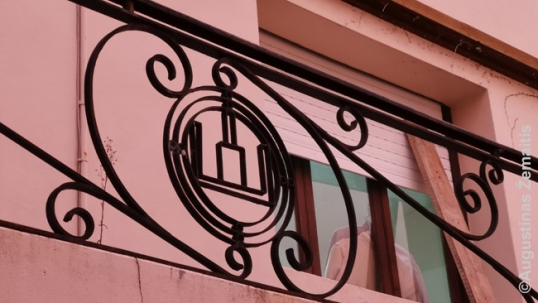
Coluns of Gediminas balustrade in the Lithuanian club “Nemunas”
The club building was originally constructed in 1928 (the lot acquired in 1926), upgraded in 1949. The second floor was added in 1955.
Prior to 1928, the club members would meet at the homes of fellow members. Like other similar organizations, “Nemunas” began its history as a self-help society (prior to the reign of president Juan Peron in 1940s-1950s, Argentina lacked social security and so immigrants of the same ethnicity would pool parts of their salaries in order to help the members in dire straits, especially those injured and widowed). Naturally, ethnic activities also took place under the same roof as all the members were immigrants who grew up surrounded by the same Lithuanian culture. Many of them did not even speak Spanish well.
After World War 2, as social security laws were implemented, the need to have a self-help community dissipated and thus the ethnic heritage took the upper hand in “Nemunas” activities. At the time, people who grew up in Argentina slowly took over the ranks of the organization and to them, the Lithuanian culture was not really unquestionable-and-single-one but rather something they saw a reason to save. For instance, since 1940, the club documents are all written in Spanish as the language was already better understood than Lithuanian to more and more members. However, this did not mean Lithuanian language was forgotten - even some of the youngest members still speak Lithuanian to this day, contrary to a vast majority of similar 100-year-old Lithuanian organizations worldwide that were not replenished by new immigrants.

Main hall of the club “Nemunas”
Historically, “Nemunas” was known as “Vargdienis” (literally “poor man”) and was associated with the tautinininkai (moderate nationalists) and leftists. In 1939, the club renamed itself “Lithuanian tautininkai community Vargdienis”, in 1944 once again simply “Vargdienis”, in 1950 “Nemunas” after Lithuania’s longest river. Currently, the organization lacks a political alignment.
„Nemunas” has some 150 members.
Lithuanian Catholic club “Mindaugas”
The building of Lithuanian club “Mindaugas” is similar-in-design to that of “Nemunas” but the premises are larger. In addition to a larger main hall “Mindaugas” also has a bar, a library with old books. The bar sometimes serves Lithuanian dishes: in Berisso, it is a tradition that the ethnic communities rotate in offering their own meals. City dwellers of various ethnicities then go to taste the meals and this also helps to draw funds to the clubs.
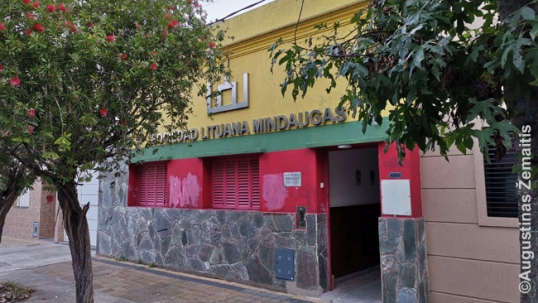
Lithuanian club “Mindaugas” of Berisso
The building of “Mindaugas” is painted in the colors of the Lithuanian flag. The most beautiful artwork in the club is the 2010 bas-relief located in the main corridor and depicting king Mindaugas of Lithuania carrying a cross and a sword. King Mindaugas was the first leader of Lithuania who adopted Christianity. As “Mindaugas” was established by Lithuanian Catholics, he is thus a symbolic figure. The bas-relief was created by C. Del Vio, M. Santucci, and C. Gomez who created more such thematic artworks in Beriso.
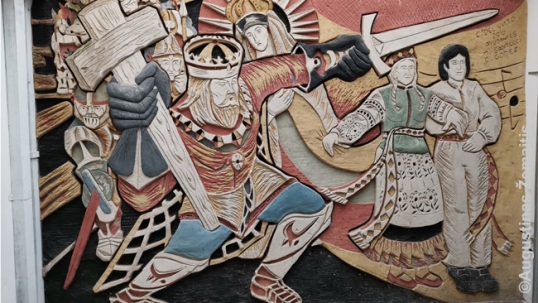
Club “Mindaugas” bas-relief
Lithuanian club “Mindaugas” was established in 1931 03 29. Among the reasons for a separate club was the fact that the leftist tendencies of "Nemunas" were viewed with suspicion by potential employers.
"Mindaugas" acquired the current building in 1943 (at that time, it was a smaller partly-wooden building). The main hall was built in 1974-1979. Although Berisso never had a Lithuanian church, Lithuanian priests from Buenos Aires Lithuanian parish of Our Lady of Vilnius (less than 100 km away) used to come here to cater to the Lithuanian Catholics of “Mindaugas”.
Club “Mindaugas” hosts numerous interesting artworks by priest A. Lubickas, each of them depicting Lithuanian topics. The most important of these works is in the main hall. Created in 1980, it depicts the most famous Lithuanian buildings, Lithuanian folk costumes, both secular and religious Lithuanian symbols. The club also has a painting “The coronation of Mindaugas” by A. Varnas.

A fragment of priest Lubickas main work
The main hall of “Mindaugas” has even more ethnic décor, such as a stylized castle of Gediminas, Vytis, a window glowing in colors of the Lithuanian flag, Columns of Gediminas on the floor, etc. The glass entrance to the hall is adorned by Mindaugas with a sword in hands. There is also a copy of Lithuania’s declaration of independence.

The hall of club “Mindaugas”
Beyond the main hall, there are recreational premises and meat preparation grill (meat BBQs, known as asado, are especially important in the Argentine culture). A Lithuanian traditional cross was erected there in 2019.
Nowadays the club hosts Lithuanian dances and choir. “Mindaugas” has unusual Lithuanian folk costumes; as immigration from Lithuania to Argentina took place at the time when colored depictions were still uncommon in print, Berisso Lithuanians of the generations born in Argentina had to create their clothes based on black-and-white depictions alone.
„Mindaugas“ has some 80 members.
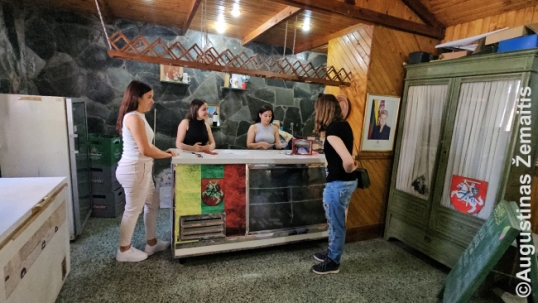
Bar of "Mindaugas"
Berisso Lithuanian monuments
The heritage of Berisso immigrants is enshrined in many names and monuments. The most important Lithuanian monument has been erected in 2009 to commemorate the 1000-year-anniversary of the first mentioning of word “Lithuania” in writing. It was built jointly by both Lithuanian clubs of the city and serves as the location for annual Lithuanian Independence Day celebrations.
The sculptural composition includes a traditional Lithuanian chapel-post with Rūpintojėlis figure of pensive Christ on top. It is surrounded by four oak trees (oak being the national tree of Lithuania) and a commemorative plaque painted in colors of Lithuanian flag that explains the meaning of the monument, as well as its dedication to the Lithuanians of Berisso and nearby La Plata and Ensenada cities. The composition is on the east coast of Saladero river, approximately at coordinates -34.868401, -57.887988.
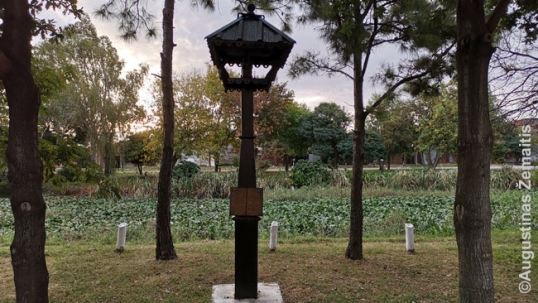
Berisso Lithuanian chapel-post
Berisso also has a Lituania Street - however, only some maps show this name. In other maps, the same street is called “169th Street” or “Larrea Street”. For a long time, no local sign "Lithuania" existed but a sign was put in place in 2020s with both of the official street names - 169th and Lituania. Larrea is the former name, used before the name Lithuania was given.
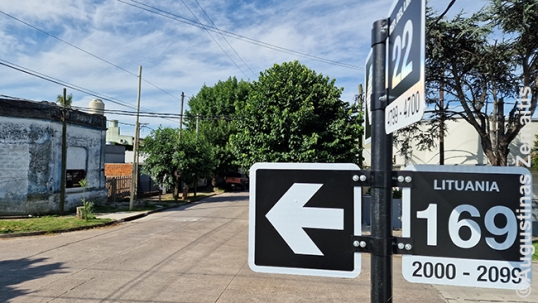
Lituania Street in Berisso
In the center of Berisso, there is a common Immigrant monument adorned with flags of all the source-countries of Beriso’s immigrant communities. It is here where the Olympic-like fire burns during the Immigrant festivals which are among the key reasons why the immigrant heritage continues to be "cool" for the young generations of Berissoans. A plaque explains that these festivals take place since 1977.
The flamboyant month-long immigrant festivals of Berisso are arguably the largest in Argentina. They include events such as a symbolic disembarcation of immigrants (now re-enacted by their (great) grandchildren), the parade of the immigrant flame (which, like the Olympic flame, begins at the Greek club and goes from club to club), ethnic dances and various competitions such as a girl pageant, where each girl represents a particular ethnic group of Berisso.

Berisso Immigrant memorial with the flags, among them Lithuanain flag
Berisso Museum has lots of artifacts related to Berisso Lithuanians, including many old pictures, things donated by Lithuannians, as well as information. In the long list of town's ethnic clubs, Lithuanian "Nemunas" is declared to be the oldest one, together with the Greek club.
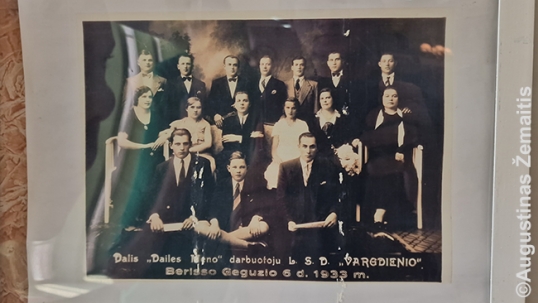
An image in Berisso museum showing "Nemunas" (then "Vargdienis") members
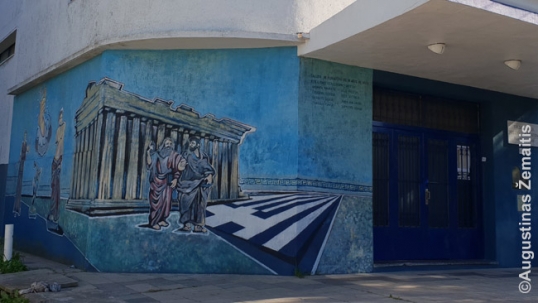
Berisso Greek club. Many of the Beriso’s ethnic clubs have interesting and artful ethnicity-inspired facades
Historically, many of the immigrants to Berisso lived in Calle Nueva York which became sort of open-air museum now. The buildings of the stockyard where most Lithuanian men worked are still intact. Just after passing the gates one may see a large mural depicting the ethnic communities of Berisso. The mural incorporates Lithuanian dancers in fol costumes, two Lithuanian flags, as well as general experiences of the early 20th century immigrants such as a disembarkation from a boat.
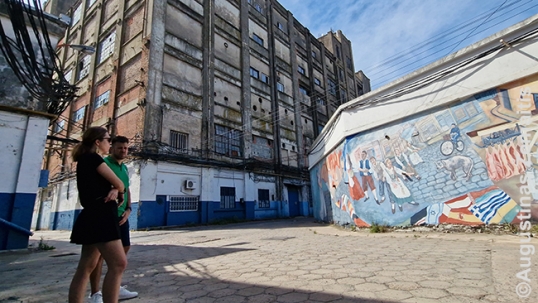
Stockyards of Berisso

A fragment of the stockyard mural in Berisso




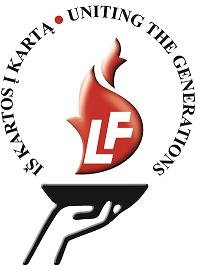

Leave a comment